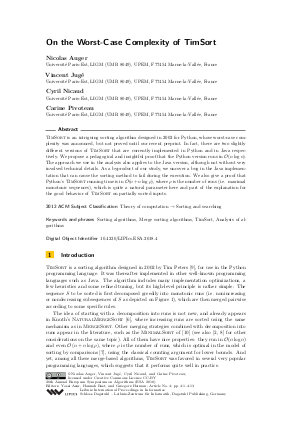On the Worst-Case Complexity of TimSort
Authors Nicolas Auger, Vincent Jugé, Cyril Nicaud, Carine Pivoteau
-
Part of:
Volume:
26th Annual European Symposium on Algorithms (ESA 2018)
Part of: Series: Leibniz International Proceedings in Informatics (LIPIcs)
Part of: Conference: European Symposium on Algorithms (ESA) - License:
 Creative Commons Attribution 3.0 Unported license
Creative Commons Attribution 3.0 Unported license
- Publication Date: 2018-08-14
File

PDF
LIPIcs.ESA.2018.4.pdf
- Filesize: 0.6 MB
- 13 pages
Document Identifiers
Subject Classification
ACM Subject Classification
- Theory of computation → Sorting and searching
Keywords
- Sorting algorithms
- Merge sorting algorithms
- TimSort
- Analysis of algorithms
Metrics
- Access Statistics
-
Total Accesses (updated on a weekly basis)
0Document
0Metadata
Abstract
TimSort is an intriguing sorting algorithm designed in 2002 for Python, whose worst-case complexity was announced, but not proved until our recent preprint. In fact, there are two slightly different versions of TimSort that are currently implemented in Python and in Java respectively. We propose a pedagogical and insightful proof that the Python version runs in O(n log n). The approach we use in the analysis also applies to the Java version, although not without very involved technical details. As a byproduct of our study, we uncover a bug in the Java implementation that can cause the sorting method to fail during the execution. We also give a proof that Python's TimSort running time is in O(n + n log rho), where rho is the number of runs (i.e. maximal monotonic sequences), which is quite a natural parameter here and part of the explanation for the good behavior of TimSort on partially sorted inputs.
Cite As Get BibTex
Nicolas Auger, Vincent Jugé, Cyril Nicaud, and Carine Pivoteau. On the Worst-Case Complexity of TimSort. In 26th Annual European Symposium on Algorithms (ESA 2018). Leibniz International Proceedings in Informatics (LIPIcs), Volume 112, pp. 4:1-4:13, Schloss Dagstuhl – Leibniz-Zentrum für Informatik (2018)
https://doi.org/10.4230/LIPIcs.ESA.2018.4
BibTex
@InProceedings{auger_et_al:LIPIcs.ESA.2018.4,
author = {Auger, Nicolas and Jug\'{e}, Vincent and Nicaud, Cyril and Pivoteau, Carine},
title = {{On the Worst-Case Complexity of TimSort}},
booktitle = {26th Annual European Symposium on Algorithms (ESA 2018)},
pages = {4:1--4:13},
series = {Leibniz International Proceedings in Informatics (LIPIcs)},
ISBN = {978-3-95977-081-1},
ISSN = {1868-8969},
year = {2018},
volume = {112},
editor = {Azar, Yossi and Bast, Hannah and Herman, Grzegorz},
publisher = {Schloss Dagstuhl -- Leibniz-Zentrum f{\"u}r Informatik},
address = {Dagstuhl, Germany},
URL = {https://drops.dagstuhl.de/entities/document/10.4230/LIPIcs.ESA.2018.4},
URN = {urn:nbn:de:0030-drops-94678},
doi = {10.4230/LIPIcs.ESA.2018.4},
annote = {Keywords: Sorting algorithms, Merge sorting algorithms, TimSort, Analysis of algorithms}
}
Author Details
References
- Nicolas Auger, Cyril Nicaud, and Carine Pivoteau. Merge strategies: From Merge Sort to TimSort. Research Report hal-01212839, hal, 2015. URL: https://hal-upec-upem.archives-ouvertes.fr/hal-01212839.
- Jérémy Barbay and Gonzalo Navarro. On compressing permutations and adaptive sorting. Theor. Comput. Sci., 513:109-123, 2013. URL: http://dx.doi.org/10.1016/j.tcs.2013.10.019.
-
Bernhard Beckert, Reiner Hähnle, and Peter H Schmitt. Verification of object-oriented software: The KeY approach. Springer-Verlag, 2007.

- Sam Buss and Alexander Knop. Strategies for stable merge sorting. Research Report abs/1801.04641, arXiv, 2018. URL: http://arxiv.org/abs/1801.04641.
-
Stijn De Gouw, Jurriaan Rot, Frank S de Boer, Richard Bubel, and Reiner Hähnle. OpenJDK’s Java.utils.Collection.sort() is broken: The good, the bad and the worst case. In International Conference on Computer Aided Verification, pages 273-289. Springer, 2015.

-
Donald E. Knuth. The Art of Computer Programming, Volume 3: (2nd Ed.) Sorting and Searching. Addison Wesley Longman Publish. Co., Redwood City, CA, USA, 1998.

- Heikki Mannila. Measures of presortedness and optimal sorting algorithms. IEEE Trans. Computers, 34(4):318-325, 1985. URL: http://dx.doi.org/10.1109/TC.1985.5009382.
-
J. Ian Munro and Sebastian Wild. Nearly-optimal mergesorts: Fast, practical sorting methods that optimally adapt to existing runs. In Hannah Bast Yossi Azar and Grzegorz Herman, editors, 26th Annual European Symposium on Algorithms (ESA 2018), Leibniz International Proceedings in Informatics (LIPIcs), pages 63:1-63:15, 2018.

- Tim Peters. Timsort description, accessed june 2015. URL: http://svn.python.org/projects/python/trunk/Objects/listsort.txt.
-
Tadao Takaoka. Partial solution and entropy. In Rastislav Královič and Damian Niwiński, editors, Mathematical Foundations of Computer Science 2009, pages 700-711, Berlin, Heidelberg, 2009. Springer Berlin Heidelberg.

